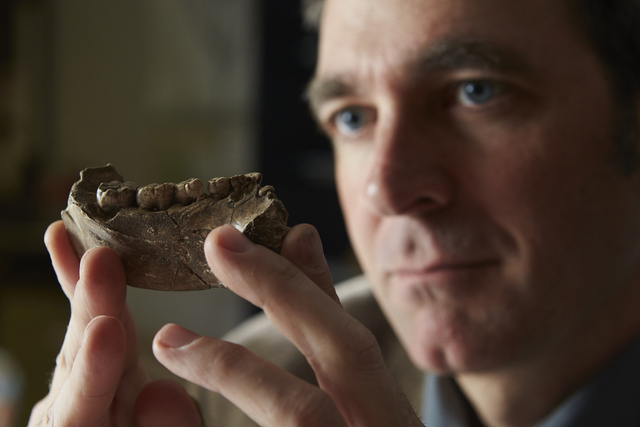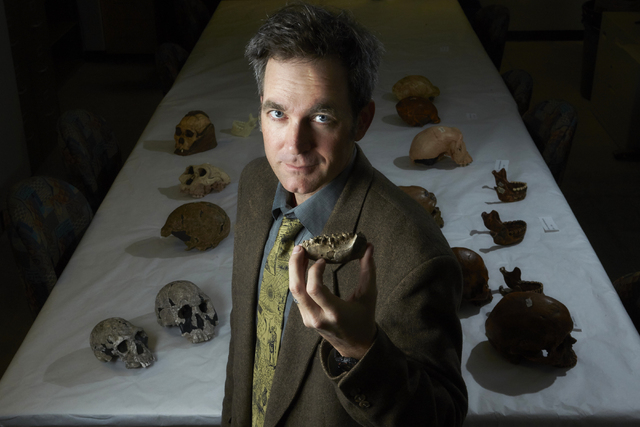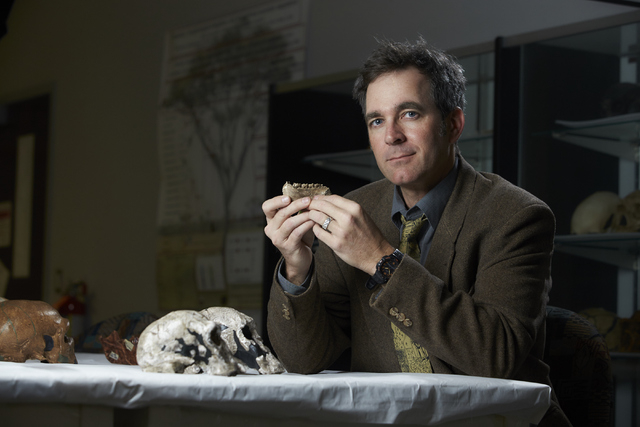UNLV anthropologist helped unearth jaw of earliest human



Someone’s going to have to update Wikipedia.
A group of scientists, including UNLV anthropologist Brian Villmoare, discovered in Ethiopia the oldest fossilized remains of the Homo genus — think a really, really long-departed cousin.
The scientists found the jawbone with five teeth still attached from the human-ape creature that lived 2.8 million years ago, or, if you’re counting by hours, it’s roughly 24.5 billion episodes of “Keeping up with the Kardashians.”
The dawn of man had been estimated to be somewhere between 2 million to 3 million years ago.
“In spite of a lot of searching, fossils on the Homo lineage older than 2 million years ago are very rare,” Villmoare said. “To have a glimpse of the very earliest phase of our lineage’s evolution is particularly exciting.”
The discovery of the fossil, which was made public on Wednesday in the online issue of the journal Science, was made two years ago by the Ledi-Geraru Research Project in the Afar Regional State in Ethiopia, north of that nation’s capital of Addis Ababa.
It’s also known as the middle of nowhere Ethiopia, Villmoare said.
It was found by Arizona State University graduate student Chalachew Seyoum on Jan. 29, 2013.
But it wasn’t found quickly. The area had been targeted by geologists who tested the desert area and found the right type of volcanic layers that date back 3 million years.
The group had been searching since about 2003, Villmoare said. For a decade he and other researchers searched for fossils. The 47-year-old professor would spend four- to six-week stints at the research site over the years.
Villmoare was in Ethiopia the day the jaw was found and recalled the relief he and his fellow researchers felt.
“We’d been looking for it for 10 years,” Villmoare said. “It was like, ‘Thank God.’ ”
Soon after, “it’s possible there was some celebrating,” he said. After 10 years of combing the Ethiopian desert, a run was made to a nearby town to purchase some sudsy libations, a Budweiser-like lager popular in the Horn of Africa known as St. George.
William Kimbel of Arizona State University’s Institute of Human Origins, which is home to the Ledi-Geraru Research Project, called it a significant find.
Analysis of the left, lower jaw and the teeth revealed slim molars, symmetrical premolars and an evenly proportioned jaw that distinguished the jaw as part of the Homo lineage from the more apelike Australopithecus. However, the fossil had a sloping chin that links it to the Australopithecus species.
“The Ledi jaw helps narrow the evolutionary gap between Australopithecus and early Homo,” Kimbel said. “It’s an excellent case of a transitional fossil in a critical time period in human evolution.”
The jaw is about 400,000 years older than a previously identified fossil from the Homo lineage. Before the discovery, the oldest Homo fossil, also found in Ethiopia, was an upper jaw estimated to be 2.3 million years old.
Until the discovery, the evolutionary period of the Homo genus has been cloudy, as fossilized remains have been difficult to find.
The jaw’s discovery “presents morphology that we interpret as transitional between Australopithecus and Homo,” Villmoare wrote in a 14-page paper.
Although Villmoare explains that climate shifts about 3 million years ago are often credited with leading to the beginning of the dawn of humans and our ancestors, there still is far too little known of the evolutionary process to make such links.
The Ledi jaw confirms the change from Australopithecus to Homo, but “additional discoveries are needed to determine whether or not these” changes included more than dental morphing or also included brain and skull expansion, technological innovation or other behavioral and anatomy changes, Villmoare wrote.
In other words, while the Kardashians may have jaw and dental structures closely related to the recent discovery, it remains a bit unclear if their brains are much larger than those of our earliest ancestors.
Contact Francis McCabe at fmccabe@reviewjournal.com or702-224-5512. Find him on Twitter: @fjmccabe.












